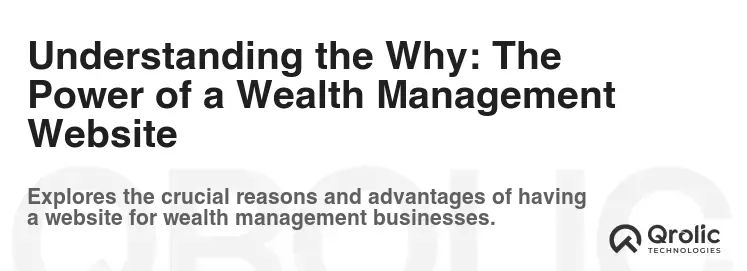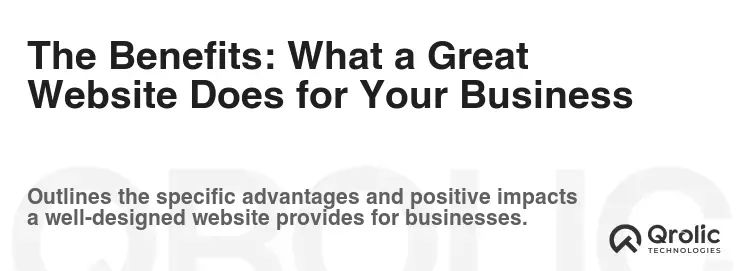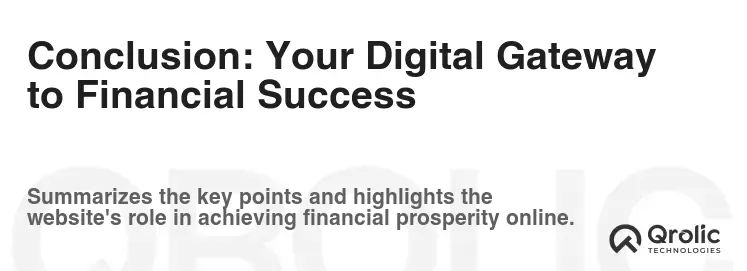Quick Summary:
- Your wealth management website is a must-have.
- Plan, design, and secure it carefully.
- Create great content and optimize for search.
- Update and promote your site regularly.
Table of Contents
- Understanding the Why: The Power of a Wealth Management Website
- Why Your Wealth Management Firm Needs a Website
- Identifying Your Target Audience: Who Are You Trying to Reach?
- Setting Clear Goals and Objectives for Your Website
- The How: Building Your Wealth Management Website – A Step-by-Step Guide
- Step 1: Planning and Strategy
- 1.1 Choosing a Domain Name: Your Online Address
- 1.2 Selecting a Web Hosting Provider: Your Website’s Home
- 1.3 Defining Your Website Structure and Navigation: Guiding Your Visitors
- Step 2: Design and Development
- 2.1 Choosing a Website Platform: CMS, Custom Development, or Website Builder?
- 2.2 Designing a User-Friendly and Visually Appealing Website: Capturing Attention
- 2.3 Implementing Security Measures: Protecting Sensitive Data
- Step 3: Content Creation
- 3.1 Crafting Compelling and Informative Content: Engaging Your Audience
- 3.2 optimizing Content for Search Engines (SEO): Getting Found Online
- 3.3 Creating a Blog: Establishing Thought Leadership
- Step 4: Testing and Launch
- 4.1 Thoroughly Testing Your Website: Ensuring a Smooth Experience
- 4.2 Launching Your Website: Making it Live
- 4.3 Promoting Your Website: Driving Traffic and Awareness
- Step 5: Maintenance and Optimization
- 5.1 Regularly Updating Your Website: Keeping it Fresh and Secure
- 5.2 Monitoring Website Performance: Tracking Key Metrics
- 5.3 Adapting to Changing Trends and Technologies: Staying Ahead of the Curve
- The Benefits: What a Great Website Does for Your Business
- Increased Client Acquisition: Reaching a Wider Audience
- Enhanced Brand Credibility: Building Trust and Authority
- Improved Client Communication: Staying Connected
- Competitive Advantage: Standing Out from the Crowd
- Cost-Effective Marketing: Maximizing Your ROI
- Partnering with Experts: When to Seek Professional Help
- Identifying the Need for Professional Assistance
- Choosing the Right Web Design and Development Agency
- Qrolic Technologies: Your Partner in Digital Success
- Conclusion: Your Digital Gateway to Financial Success
Understanding the Why: The Power of a Wealth Management Website

Why Your Wealth Management Firm Needs a Website
In today’s digital age, a wealth management website isn’t just an option; it’s a necessity. Think of it as your 24/7 virtual office, constantly working to attract new clients, nurture existing relationships, and solidify your firm’s reputation. Let’s break down why it’s so crucial:
- Establish Credibility and Trust: In the world of finance, trust is paramount. A professionally designed website showcases your expertise, experience, and commitment to your clients’ financial well-being. It’s the first impression you make, and it needs to be a strong one. Think of it as your digital handshake – firm, confident, and reassuring.
- Expand Your Reach and Attract New Clients: Gone are the days of relying solely on word-of-mouth referrals. A website allows you to reach a wider audience, attracting potential clients who are actively searching for wealth management services online. It’s like casting a wider net to capture more opportunities.
- Showcase Your Services and Expertise: Your website is the perfect platform to highlight your unique value proposition, detailing the services you offer, the markets you serve, and the results you achieve for your clients. It’s your chance to tell your story and demonstrate why you’re the best choice for their financial needs.
- Provide Valuable Resources and Educational Content: By offering informative articles, market updates, financial planning tools, and other valuable resources, you can position yourself as a thought leader and build trust with potential clients. This shows you’re not just selling services, but also genuinely invested in their financial literacy.
- Improve Client Communication and Engagement: A website can serve as a central hub for client communication, providing access to account information, performance reports, and other important documents. It streamlines communication and makes it easier for clients to stay informed about their investments.
- Stay Competitive in a Digital World: In an increasingly competitive landscape, having a strong online presence is essential to stand out from the crowd. A well-designed website demonstrates that you’re forward-thinking, adaptable, and committed to providing the best possible service to your clients.
- Generate Leads and Drive Business Growth: Ultimately, the goal of your website is to generate leads and drive business growth. By incorporating lead capture forms, call-to-action buttons, and other conversion-focused elements, you can turn website visitors into qualified prospects.
Identifying Your Target Audience: Who Are You Trying to Reach?
Before you even begin designing your website, you need to clearly define your target audience. Understanding their needs, preferences, and online behavior is crucial for creating a website that resonates with them and attracts them to your services. Consider these factors:
- Demographics: Age, income, location, education level, occupation.
- Financial Goals: Retirement planning, wealth accumulation, estate planning, investment management.
- Investment Knowledge: Beginner, intermediate, advanced.
- Risk Tolerance: Conservative, moderate, aggressive.
- Online Behavior: What websites do they visit? What social media platforms do they use? What keywords do they search for?
By understanding your target audience, you can tailor your website’s content, design, and messaging to appeal directly to them. This will increase engagement, generate more leads, and ultimately drive business growth.
Setting Clear Goals and Objectives for Your Website
What do you want your website to achieve? Before you start building, define specific, measurable, achievable, relevant, and time-bound (SMART) goals. Here are some examples:
- Increase Website Traffic by X% within Y months.
- Generate X number of leads per month through contact forms.
- Improve client satisfaction scores by X% based on website usability.
- Increase brand awareness and recognition within your target market.
- Drive X number of appointment bookings per month.
Having clear goals and objectives will help you stay focused, track your progress, and make data-driven decisions to optimize your website for success.
The How: Building Your Wealth Management Website – A Step-by-Step Guide

Step 1: Planning and Strategy
1.1 Choosing a Domain Name: Your Online Address
Your domain name is your website’s address on the internet. It should be memorable, relevant to your business, and easy to spell. Consider these tips:
- Keep it short and simple: Avoid hyphens, numbers, and unusual spellings.
- Use relevant keywords: Incorporate keywords related to wealth management or your firm’s name.
- Choose the right extension: .com is the most common and preferred extension, but .net or .org may also be suitable.
- Check availability: Use a domain name registrar like GoDaddy or Namecheap to check if your desired domain name is available.
- Protect your brand: Register variations of your domain name to prevent competitors from using similar names.
1.2 Selecting a Web Hosting Provider: Your Website’s Home
Your web hosting provider is responsible for storing your website’s files and making them accessible to visitors. Choose a provider that offers:
- Reliability and uptime: Look for a provider with a proven track record of high uptime (ideally 99.9% or higher).
- Scalability: Choose a provider that can accommodate your website’s growing traffic and storage needs.
- Security: Ensure the provider offers robust security measures to protect your website from hacking and malware.
- Customer support: Choose a provider with responsive and helpful customer support in case you encounter any issues.
- Pricing: Compare pricing plans and choose one that fits your budget and needs. Popular hosting providers include Bluehost, HostGator, and SiteGround.
1.3 Defining Your Website Structure and Navigation: Guiding Your Visitors
Plan the structure of your website to ensure visitors can easily find the information they need. A well-organized website improves user experience and encourages visitors to stay longer. Consider these essential pages:
- Homepage: Your website’s welcome mat. It should grab attention, clearly state your value proposition, and guide visitors to other important pages.
- About Us: Tell your firm’s story, highlight your team’s expertise, and build trust with potential clients.
- Services: Detail the services you offer, such as financial planning, investment management, and retirement planning.
- Resources: Provide valuable content like articles, market updates, and financial planning tools.
- Contact Us: Make it easy for visitors to get in touch with you through a contact form, phone number, or email address.
- Blog: Share your insights on financial topics, market trends, and industry news to establish thought leadership.
Step 2: Design and Development
2.1 Choosing a Website Platform: CMS, Custom Development, or Website Builder?
Selecting the right platform is crucial for building a website that meets your needs and budget. Consider these options:
- Content Management System (CMS): wordpress is the most popular CMS, offering flexibility, customization, and a wide range of plugins and themes. Other CMS options include Joomla and Drupal.
- Custom Development: This option involves hiring a web developer to build your website from scratch. It offers the most flexibility but is also the most expensive and time-consuming.
- Website Builder: Website builders like Wix, Squarespace, and Weebly offer drag-and-drop interfaces and pre-designed templates, making it easy to create a website without coding knowledge. They are a good option for simple websites but may lack the flexibility and customization of a CMS.
For wealth management websites, a CMS like WordPress is often the best choice, offering a balance of flexibility, customization, and affordability.
2.2 Designing a User-Friendly and Visually Appealing Website: Capturing Attention
Your website’s design should be professional, visually appealing, and user-friendly. Consider these design principles:
- Clean and uncluttered layout: Avoid overwhelming visitors with too much information or visual clutter.
- Mobile-responsiveness: Ensure your website looks and functions well on all devices, including smartphones and tablets.
- Consistent branding: Use your firm’s logo, colors, and fonts consistently throughout your website.
- High-quality images and videos: Use professional-quality visuals to enhance your website’s appeal and credibility.
- Clear call-to-action buttons: Use prominent call-to-action buttons to guide visitors to take desired actions, such as contacting you or requesting a consultation.
- Easy navigation: Make it easy for visitors to find the information they need with clear and intuitive navigation.
- Accessibility: Design your website to be accessible to people with disabilities, following accessibility guidelines like WCAG.
2.3 Implementing Security Measures: Protecting Sensitive Data
Security is paramount for wealth management websites. Implement these security measures to protect your website and your clients’ data:
- SSL Certificate: Install an SSL certificate to encrypt data transmitted between your website and visitors’ browsers.
- Strong Passwords: Use strong and unique passwords for all your website accounts.
- Regular Backups: Back up your website regularly to prevent data loss in case of a security breach or technical issue.
- Security Plugins: Use security plugins to protect your website from hacking, malware, and other threats.
- Firewall: Implement a firewall to block malicious traffic from accessing your website.
- Regular Updates: Keep your website platform, plugins, and themes up to date to patch security vulnerabilities.
- Data Privacy Policy: Clearly outline your data privacy policy and how you protect your clients’ personal information.
Step 3: Content Creation
3.1 Crafting Compelling and Informative Content: Engaging Your Audience
Your website’s content should be informative, engaging, and relevant to your target audience. Consider these content creation tips:
- Know your audience: Tailor your content to the needs and interests of your target audience.
- Use clear and concise language: Avoid jargon and technical terms that your audience may not understand.
- Focus on the benefits: Highlight the benefits of your services and how you can help clients achieve their financial goals.
- Tell stories: Use stories and testimonials to connect with your audience on an emotional level.
- Use visuals: Incorporate images, videos, and infographics to break up text and enhance engagement.
- Optimize for search engines: Use relevant keywords throughout your content to improve your website’s search engine ranking.
- Proofread carefully: Ensure your content is free of errors in grammar and spelling.
- Maintain a consistent brand voice: Use a consistent tone and style throughout your website.
3.2 optimizing Content for Search Engines (SEO): Getting Found Online
Search engine optimization (SEO) is the process of optimizing your website to rank higher in search engine results pages (SERPs). This will help you attract more organic traffic to your website. Consider these SEO best practices:
- Keyword research: Identify the keywords that your target audience is using to search for wealth management services.
- On-page optimization: Optimize your website’s title tags, meta descriptions, headings, and content with relevant keywords.
- Off-page optimization: Build high-quality backlinks from other reputable websites to improve your website’s authority and ranking.
- Technical SEO: Ensure your website is mobile-friendly, loads quickly, and is easy for search engines to crawl and index.
- Content marketing: Create high-quality content that is valuable to your target audience and attracts backlinks and social shares.
- Local SEO: Optimize your website for local search by claiming your Google My Business listing and using local keywords.
3.3 Creating a Blog: Establishing Thought Leadership
A blog is a great way to establish thought leadership, share your insights on financial topics, and attract new visitors to your website. Consider these blog content ideas:
- Market updates: Provide regular updates on market trends and economic conditions.
- Financial planning tips: Share practical tips on budgeting, saving, and investing.
- Retirement planning advice: Offer guidance on planning for retirement and managing retirement income.
- Investment strategies: Discuss different investment strategies and how to choose the right investments for your clients.
- Client success stories: Share stories of how you have helped clients achieve their financial goals.
- Industry news and trends: Comment on industry news and trends and share your insights.
Step 4: Testing and Launch
4.1 Thoroughly Testing Your Website: Ensuring a Smooth Experience
Before launching your website, thoroughly test it to ensure everything is working properly. Test these aspects:
- Functionality: Test all forms, links, and buttons to ensure they are working correctly.
- Responsiveness: Test your website on different devices and screen sizes to ensure it is mobile-responsive.
- Cross-browser compatibility: Test your website on different browsers (Chrome, Firefox, Safari, Edge) to ensure it displays correctly.
- Performance: Test your website’s loading speed and optimize it for fast performance.
- Security: Test your website’s security measures to ensure it is protected from vulnerabilities.
- User experience: Get feedback from users on your website’s usability and design.
4.2 Launching Your Website: Making it Live
Once you have thoroughly tested your website and are satisfied with its performance, you can launch it. This involves:
- Pointing your domain name to your hosting server: Update your domain name’s DNS records to point to your hosting server.
- Uploading your website files to your hosting server: Upload your website files to your hosting server using FTP or a file manager.
- Configuring your website settings: Configure your website settings, such as your website’s title, description, and permalinks.
- Submitting your website to search engines: Submit your website to search engines like Google and Bing to get it indexed.
4.3 Promoting Your Website: Driving Traffic and Awareness
Once your website is live, you need to promote it to attract traffic and generate leads. Consider these promotion strategies:
- Search engine optimization (SEO): Continue to optimize your website for search engines to improve your organic ranking.
- Social media marketing: Share your website’s content on social media platforms to reach a wider audience.
- Email marketing: Build an email list and send out regular newsletters and updates to your subscribers.
- Paid advertising: Run paid advertising campaigns on search engines and social media platforms to target potential clients.
- Content marketing: Create high-quality content that is valuable to your target audience and attracts backlinks and social shares.
- Networking: Attend industry events and network with potential clients and partners.
- Public relations: Reach out to journalists and bloggers to get your website featured in their publications.
Step 5: Maintenance and Optimization
5.1 Regularly Updating Your Website: Keeping it Fresh and Secure
Your website is not a “set it and forget it” project. You need to regularly update it to keep it fresh, secure, and relevant. This includes:
- Updating your website platform, plugins, and themes: Keep your website platform, plugins, and themes up to date to patch security vulnerabilities and improve performance.
- Creating new content: Regularly create new content, such as blog posts, articles, and videos, to keep your website fresh and engaging.
- Updating existing content: Review and update your existing content to ensure it is accurate, relevant, and optimized for search engines.
- Monitoring your website’s performance: Monitor your website’s traffic, bounce rate, and conversion rate to identify areas for improvement.
- Analyzing your website’s data: Analyze your website’s data to understand your audience’s behavior and preferences.
5.2 Monitoring Website Performance: Tracking Key Metrics
Track key metrics to measure your website’s performance and identify areas for improvement. These metrics include:
- Website traffic: The number of visitors to your website.
- Bounce rate: The percentage of visitors who leave your website after viewing only one page.
- Conversion rate: The percentage of visitors who take a desired action, such as contacting you or requesting a consultation.
- Time on site: The average amount of time visitors spend on your website.
- Pageviews per session: The average number of pages visitors view per session.
- Search engine ranking: Your website’s ranking in search engine results pages (SERPs).
- Social media engagement: The number of likes, shares, and comments on your social media posts.
5.3 Adapting to Changing Trends and Technologies: Staying Ahead of the Curve
The digital landscape is constantly evolving. Stay up-to-date on the latest trends and technologies to ensure your website remains competitive. This includes:
- Mobile-first design: Prioritize mobile-friendliness in your website’s design and development.
- Voice search optimization: Optimize your website for voice search by using natural language and answering common questions.
- Artificial intelligence (AI): Explore how AI can be used to improve your website’s user experience and personalize content.
- Video marketing: Incorporate video into your website to engage visitors and communicate your message more effectively.
- Data analytics: Use data analytics to understand your audience’s behavior and preferences and make data-driven decisions.
The Benefits: What a Great Website Does for Your Business

Increased Client Acquisition: Reaching a Wider Audience
A well-optimized website acts as a powerful lead generation tool, expanding your reach and attracting new clients who are actively searching for wealth management services online.
Enhanced Brand Credibility: Building Trust and Authority
A professionally designed and informative website enhances your firm’s credibility and builds trust with potential clients, establishing you as a reliable and knowledgeable resource in the industry.
Improved Client Communication: Staying Connected
A website provides a central hub for client communication, offering access to account information, performance reports, and other important documents, streamlining communication and improving client satisfaction.
Competitive Advantage: Standing Out from the Crowd
In today’s competitive landscape, a strong online presence is essential to stand out from the crowd, demonstrating that you’re forward-thinking, adaptable, and committed to providing the best possible service to your clients.
Cost-Effective Marketing: Maximizing Your ROI
A website offers a cost-effective marketing solution, allowing you to reach a wider audience and generate leads without breaking the bank, maximizing your return on investment.
Partnering with Experts: When to Seek Professional Help

Identifying the Need for Professional Assistance
While DIY website building tools are readily available, there are times when partnering with professionals is the smartest move. If you lack the time, technical skills, or design expertise to create a high-quality website, seeking professional assistance is a wise investment.
Choosing the Right Web Design and Development Agency
Selecting the right web design and development agency is crucial for ensuring the success of your website project. Look for an agency with experience in the financial services industry, a proven track record of success, and a team of skilled designers, developers, and marketers.
Qrolic Technologies: Your Partner in Digital Success
Qrolic Technologies (https://qrolic.com/) is a leading web design and development company specializing in creating custom websites for wealth management firms. With a deep understanding of the financial services industry and a commitment to delivering exceptional results, Qrolic Technologies can help you create a website that attracts new clients, enhances your brand credibility, and drives business growth. Qrolic offers a range of services including:
- Custom website design and development
- Content management system (CMS) implementation
- Search engine optimization (SEO)
- Social media marketing
- Digital marketing strategy
Why Choose Qrolic Technologies?
- Industry Expertise: Qrolic has extensive experience working with wealth management firms and understands the unique challenges and opportunities in the industry.
- Custom Solutions: Qrolic creates custom websites tailored to your specific needs and goals, ensuring your website reflects your brand and appeals to your target audience.
- Proven Results: Qrolic has a proven track record of delivering successful website projects that generate leads and drive business growth.
- Dedicated Support: Qrolic provides dedicated support throughout the website design and development process, ensuring your project is completed on time and within budget.
- Cutting-Edge Technology: Qrolic uses the latest technologies and design trends to create websites that are visually appealing, user-friendly, and optimized for search engines.
Qrolic Technologies can empower your wealth management firm with a robust, visually appealing, and high-performing website designed to attract and retain clients.
Conclusion: Your Digital Gateway to Financial Success

Creating a wealth management website is an investment in your firm’s future. By following this step-by-step guide, you can create a website that attracts new clients, enhances your brand credibility, and drives business growth. Remember to focus on user experience, create valuable content, and optimize your website for search engines. Whether you choose to build your website yourself or partner with a professional agency like Qrolic Technologies, a well-designed and optimized website is essential for success in today’s digital age. Embrace the power of the internet and create a digital gateway to financial success for your firm.







